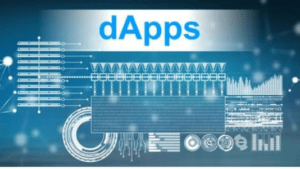Table of Contents:
Introduction
- 1.1 Web 3.0: An Overview
- 1.2 Blockchain Technology: Key Concepts
Blockchain Technology in Finance
- 2.1 Decentralized Finance (DeFi)
- 2.2 Tokenization and Asset Management
- 2.3 Cross-Border Payments
Blockchain Technology in Supply Chain
- 3.1 Traceability and Provenance
- 3.2 Supply Chain Transparency
- 3.3 Smart Contracts and Automation
Blockchain Technology in Healthcare
- 4.1 Secure Data Exchange and Interoperability
- 4.2 Health Records Management
- 4.3 Clinical Trials and Research
Blockchain Technology in Identity Management
- 5.1 Self-Sovereign Identity (SSI)
- 5.2 Identity Verification and Authentication
- 5.3 Privacy and Data Protection
Blockchain Technology in Decentralized Applications (dApps)
- 6.1 Decentralized Storage and Content Distribution
- 6.2 Decentralized Governance and Consensus
- 6.3 Scalability and Interoperability
Case Studies
- 7.1 Ethereum: Enabling Smart Contracts and dApps
- 7.2 VeChain: Transforming Supply Chain Management
- 7.3 Sovrin: Empowering Self-Sovereign Identity
- 7.4 Filecoin: Decentralized File Storage
Challenges and Limitations
- 8.1 Scalability and Throughput
- 8.2 Energy Consumption
- 8.3 Regulatory and Legal Frameworks
Future Directions and Conclusion
1.1 Web 3.0: An Overview:
The internet has undergone significant transformations over the years, moving from Web 1.0 (static webpages) to Web 2.0 (interactive and user-generated content). Web 3.0 represents the next phase, where the internet evolves into a decentralized and user-centric ecosystem. It aims to empower individuals, enhance privacy, and enable peer-to-peer interactions through emerging technologies like blockchain, artificial intelligence, and the Internet of Things (IoT).
1.2 Blockchain Technology: Key Concepts:
Blockchain technology, at its core, is a distributed ledger that enables secure and transparent recording of transactions and data. It operates on a decentralized network of nodes that validate and store information in a chronological and immutable manner. Key concepts in blockchain include consensus mechanisms, cryptographic techniques, and smart contracts, which allow for programmable and self-executing agreements.
Blockchain Technology in Finance:
2.1 Decentralized Finance (DeFi):
Blockchain technology has unleashed the potential of decentralized finance (DeFi), enabling permissionless access to financial services such as lending, borrowing, and trading. DeFi platforms built on blockchain networks offer improved transparency, reduced intermediaries, and increased liquidity, fostering financial inclusion and innovation.
2.2 Tokenization and Asset Management:
Blockchain-based tokenization allows for the representation of real-world assets, such as real estate or stocks, as digital tokens on the blockchain. This enables fractional ownership, increased liquidity, and efficient asset management. Tokenization has the potential to democratize access to traditionally illiquid assets, creating new investment opportunities and unlocking value.
2.3 Cross-Border Payments:
Blockchain technology has the potential to revolutionize cross-border payments by eliminating intermediaries, reducing costs, and improving transaction speed and security. Cryptocurrencies and stablecoins built on blockchain networks enable fast and borderless transactions, bypassing traditional banking systems. Examples such as Ripple and Stellar are leveraging blockchain to facilitate efficient and affordable cross-border remittances.
Blockchain Technology in Supply Chain:
3.1 Traceability and Provenance:
Blockchain technology enables end-to-end traceability and provenance in supply chains by recording and validating every transaction and movement of goods. This ensures transparency and accountability, reducing fraud, counterfeiting, and supply chain inefficiencies. For example, the VeChain blockchain platform is being used by luxury brands to authenticate and track the origin of their products, providing consumers with assurance and trust.
3.2 Supply Chain Transparency:
Blockchain technology enhances supply chain transparency by enabling real-time visibility into the movement and conditions of goods. Smart contracts and IoT devices can automatically record and verify data, ensuring compliance with regulations and standards. Walmart and IBM have collaborated on the Food Trust blockchain platform to improve food safety by tracking the journey of products from farm to table.
3.3 Smart Contracts and Automation:
Smart contracts, programmable agreements that self-execute based on predefined conditions, streamline supply chain operations and automate processes. These contracts ensure trust, efficiency, and cost savings by eliminating manual interventions and reducing the need for intermediaries. Blockchain-based supply chain platforms like TradeLens are leveraging smart contracts to automate document management, customs processes, and trade financing.
Blockchain Technology in Healthcare:
4.1 Secure Data Exchange and Interoperability:
Blockchain technology provides a secure and decentralized framework for healthcare data exchange, enabling interoperability between different healthcare providers and systems. Patient data can be stored on the blockchain, ensuring privacy, consent management, and data integrity. Projects like MedRec and Medicalchain are exploring blockchain solutions for secure health data sharing and interoperability.
4.2 Health Records Management:
Blockchain technology can transform health records management by providing patients with ownership and control over their medical data. Patients can grant access to their records to healthcare providers securely, reducing duplication of tests, improving care coordination, and enhancing patient outcomes. Estonia’s eHealth system is an example of a blockchain-based health records management solution.
4.3 Clinical Trials and Research:
Blockchain technology can enhance the transparency and integrity of clinical trials and research by securely recording trial data, protocols, and results. This enables auditable and tamper-proof records, promoting trust and ensuring the reproducibility of research findings. Projects like Scientist.com and the Clinical Trials Transformation Initiative (CTTI) are exploring blockchain solutions to improve the efficiency and transparency of clinical trials.
Blockchain Technology in Identity Management:
5.1 Self-Sovereign Identity (SSI):
Blockchain technology enables self-sovereign identity (SSI), where individuals have control over their personal data and digital identities. SSI allows for secure and verifiable identity verification without relying on centralized authorities. Projects like Sovrin and uPort are developing blockchain-based SSI solutions to empower individuals and enhance privacy and data protection.
5.2 Identity Verification and Authentication:
Blockchain-based identity solutions enable secure and efficient identity verification and authentication processes. Digital identities can be verified using cryptographic techniques, eliminating the need for multiple usernames and passwords. For example, the Civic blockchain-based identity platform enables users to verify their identities for various online services without exposing sensitive data.
5.3 Privacy and Data Protection:
Blockchain technology provides enhanced privacy and data protection by using cryptographic techniques to encrypt and secure data. It allows for selective disclosure of personal information, ensuring privacy while maintaining the necessary level of trust. The Zero Knowledge Proof (ZKP) mechanism, implemented in projects like Zcash and Monero, allows for transactions and data to be validated without revealing any sensitive information.
Blockchain Technology in Decentralized Applications (dApps):
6.1 Decentralized Storage and Content Distribution:
Blockchain technology enables decentralized storage and content distribution, eliminating the need for centralized servers and intermediaries. Projects like Filecoin and IPFS (InterPlanetary File System) leverage blockchain-based decentralized storage networks to provide efficient and censorship-resistant storage solutions for dApps and content creators.
6.2 Decentralized Governance and Consensus:
Blockchain-based dApps introduce decentralized governance models, allowing users to participate in decision-making processes through voting and consensus mechanisms. This ensures transparency, accountability, and community-driven development. The DAO (Decentralized Autonomous Organization) concept, pioneered by projects like Aragon and DAOstack, enables decentralized governance and decision-making within organizations.
6.3 Scalability and Interoperability:
Scalability and interoperability are key challenges for blockchain-based dApps. Layer 2 scaling solutions, such as state channels and sidechains, enable off-chain processing and reduce congestion on the main blockchain network. Interoperability protocols like Polkadot and Cosmos facilitate seamless communication and data exchange between different blockchain networks, enabling a more interconnected and efficient web of dApps.
Case Studies:
7.1 Ethereum: Enabling Smart Contracts and dApps:
Ethereum, the second-largest blockchain network, has been instrumental in driving Web 3.0 innovation. It introduced the concept of smart contracts, enabling the development of decentralized applications (dApps) across various sectors. Examples include decentralized finance (DeFi) platforms like Uniswap and lending protocols like Compound, which are revolutionizing the financial industry.
7.2 VeChain: Transforming Supply Chain Management:
VeChain, a blockchain platform, focuses on supply chain management and traceability. It allows businesses to record and verify every step of the supply chain, ensuring transparency, authenticity, and quality control. VeChain has collaborated with luxury brands, such as LVMH, to combat counterfeiting and provide consumers with verifiable product information.
7.3 Sovrin: Empowering Self-Sovereign Identity:
Sovrin is a blockchain-based identity platform that empowers individuals with self-sovereign identity management. It enables users to control their personal data and selectively disclose it for identity verification purposes. Sovrin aims to provide a secure and privacy-focused identity solution that eliminates the need for centralized identity authorities.
7.4 Filecoin: Decentralized File Storage:
Filecoin is a blockchain-based decentralized storage network that allows users to rent out their unused storage space and earn tokens in return. It provides an efficient and resilient storage infrastructure for dApps and content creators, ensuring data availability and censorship resistance. Filecoin incentivizes network participants to contribute storage resources, creating a decentralized and secure storage ecosystem.
Challenges and Limitations:
8.1 Scalability and Throughput:
Blockchain technology currently faces scalability and throughput challenges, with limitations in transaction processing speed and network capacity. Scaling solutions, such as sharding, off-chain processing, and layer 2 solutions, are being developed to address these challenges and enhance blockchain scalability.
8.2 Energy Consumption:
The energy consumption associated with blockchain networks, particularly proof-of-work (PoW) consensus algorithms, has raised concerns regarding sustainability and environmental impact. Research and development efforts are focused on transitioning to more energy-efficient consensus mechanisms, such as proof-of-stake (PoS), to reduce the carbon footprint of blockchain networks.
8.3 Regulatory and Legal Frameworks:
The regulatory and legal frameworks around blockchain technology are still evolving, posing challenges for its widespread adoption. Issues such as data privacy, compliance, and jurisdictional conflicts need to be addressed to ensure a conducive environment for blockchain innovation while safeguarding user rights and regulatory compliance.
Future Directions and Conclusion:
Blockchain technology continues to drive innovation in Web 3.0, disrupting traditional industries and empowering individuals with greater control over their data and digital interactions. As scalability, energy efficiency, and regulatory challenges are addressed, we can expect further adoption of blockchain technology in various sectors, including finance, supply chain, healthcare, identity management, and decentralized applications. The transformative potential of blockchain technology in creating a more efficient, trustworthy, and inclusive digital ecosystem is vast, and its impact will continue to shape the future of the internet.



